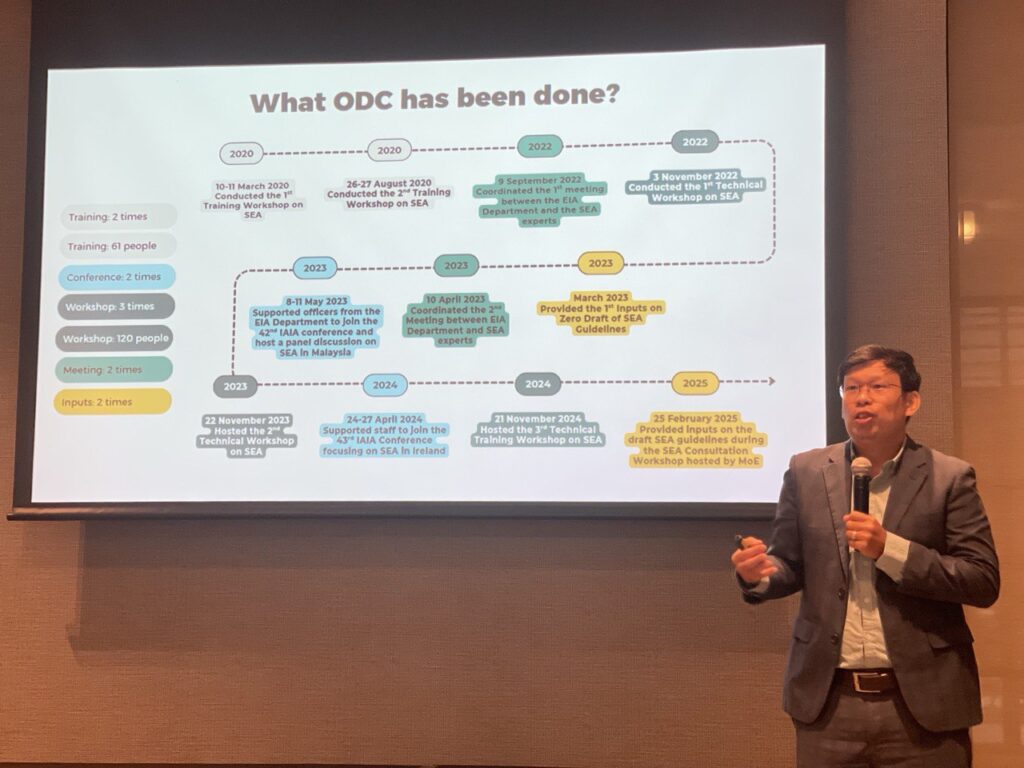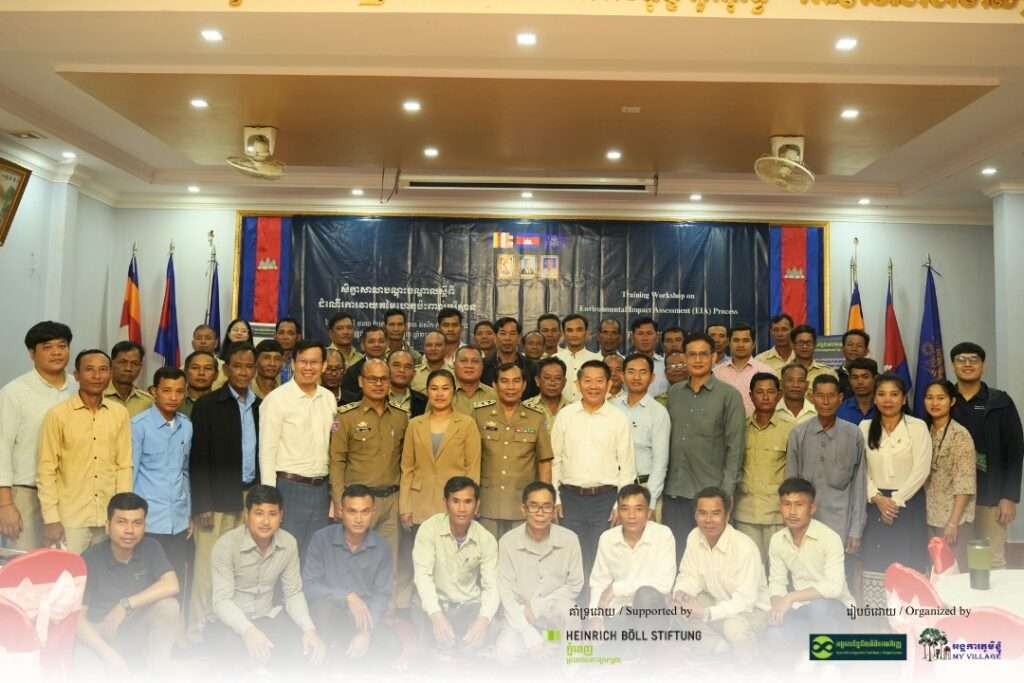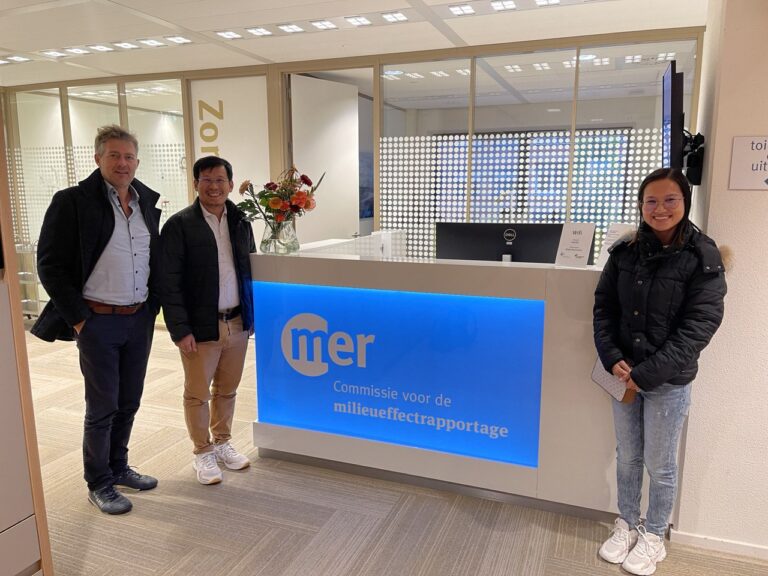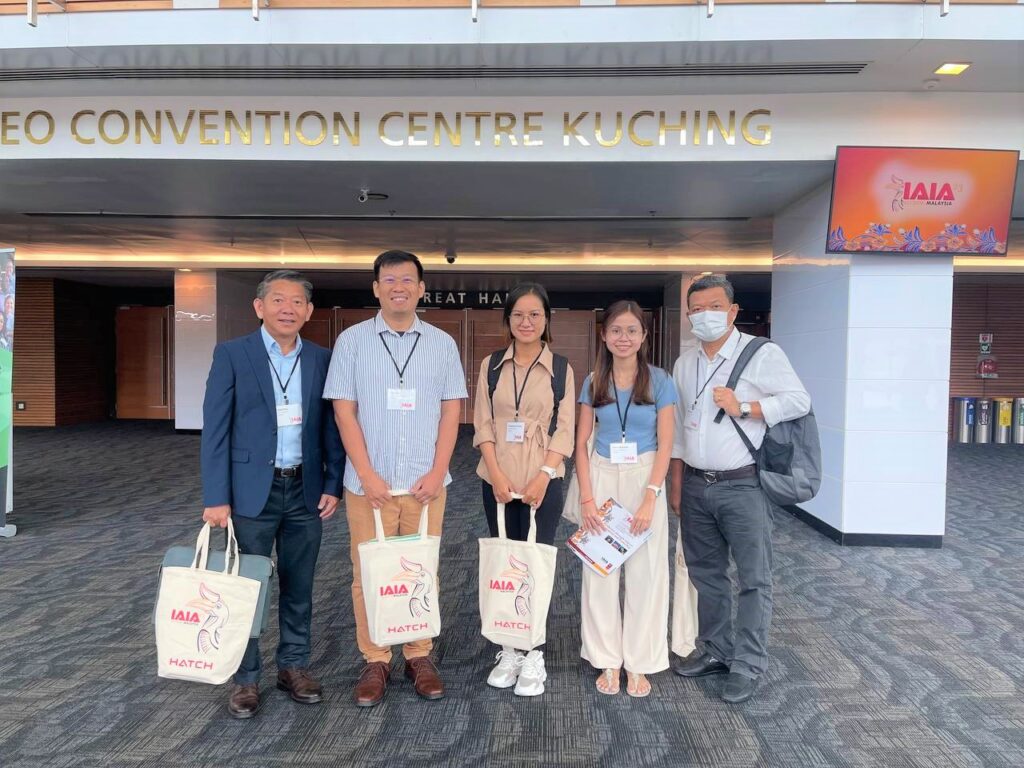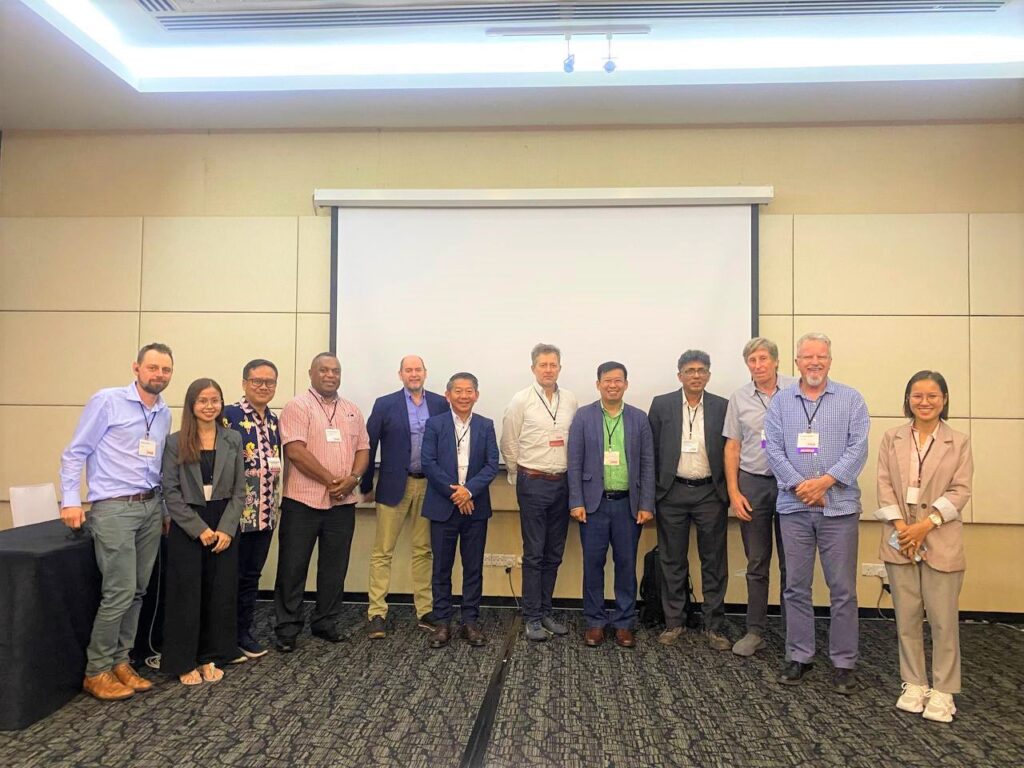Inception workshop on Strategic Environmental Assessment (SEA) phase II: ODC shares experiences on SEA
On 17 June 2025, Open Development Cambodia (ODC) participated and served as speakers at the Inception Workshop on Phase II of Strengthening the Strategic Environmental Assessment (SEA) Process through Capacity Development, a collaboration between the Ministry of Environment (MoE) and The Asia Foundation (TAF). The workshop was attended by approximately 40 participants from the Ministry of Environment (MoE), Ministry of Mines and Energy (MME), Ministry of Tourism (MoT), Ministry of Agriculture, Forestry and Fisheries (MAFF), Council for the Development of Cambodia (CDC), Ministry of Economy and Finance (MEF), Ministry of Public Works and Transport (MPWT), Ministry of Land Management, Urban Planning and Construction (MLMUPC), Ministry of Planning (MoP), Cambodia National Mekong River Committee (CNMC), Ministry of Water Resources and Meteorology (MoWRAM), Ministry of Posts and Telecommunications (MPTC), Global Green Growth Institute (GGGI), United Nations Development Programme (UNDP), World Wildlife Fund for Nature (WWF), and the Embassy of Australia. The workshop aims to (1) identify opportunities and challenges in implementing SEA in Cambodia, (2) brainstorm ideas related to the preparation of a sub-decree on SEA as stipulated in the 2023 Environment and Natural Resources (ENR) Code to support the implementation of SEA, and (3) expand capacity-building opportunities on SEA for national and sub-national officials. In 2025, MoE and TAF re-engaged to continue the SEA initiatives, beginning with a senior management meeting to discuss key issues and further advance the implementation of SEA in Cambodia. A priority task is to develop and promote the integration of SEA into policies, strategic plans, and action programs across relevant sectors. This effort aims to achieve sustainable development and support the implementation of the Pentagonal Strategy Phase I of the Royal Government of Cambodia of the Seventh Legislature of the National Assembly. SEA plays an important role in integrating environmental issues into the formulation of policies, strategic plans, and action programs in key sectors outlined in the code. H.E. Dr. Chuop Paris, Secretary of State of the MoE, presided over the opening of the workshop. On that occasion, H.E. emphasized that the implementation of the activities for the second phase is to strengthen broader cooperation on the preparation of documents for SEA covering the seven priority sectors as defined in the Nationally Determined Contributions 3.0 (NDC 3.0) document to ensure sustainable development, focusing on the three pillars: economy, society, and environment. The preparation of SEA is very important for relevant ministries and competent institutions to put forward their sectoral strategic plans to jointly achieve sustainable development and ensure a good environment that takes into account cleanliness. H.E. also emphasized that the workshop should consider preparing legal documents on SEA as stipulated in the ENR Code, such as sub-decrees or guidelines on SEA in each sector. It is also worth noting that the collaboration for Phase 1 has achieved positive results, including the completion of a study on the scope of SEA in Cambodia, capacity building for civil servants, and training of trainers in SEA. The workshop presented the current status of SEA in Cambodia, including the background of SEA in Cambodia, the latest developments, and the plans for 2025-2027. Currently, MoE is preparing the General Guidelines on SEA in Cambodia and the Guidelines on SEA for the Sand Mining Business in Cambodia. In 2025-2027, MoE will prepare a sub-decree on the SEA procedure, the SEA framework analysis, and the training of trainers (ToT). Mr. Thy Try, Executive Director and Editor-in-Chief of Open Development Cambodia (ODC), presented an overview of SEA as well as previous SEA reports. At the same time, he also presented the work that ODC has done about SEA in Cambodia, such as training, workshops, consultation meetings, conferences, and providing input to the SEA Guidelines. ODC has been working on SEA since 2020 until now. ODC collaborated with MoE and the Non-Timber Forest Products Exchange Programme (NTFP-EP Cambodia), supported by the Netherlands Committee for IUCN, to organize two training courses with approximately 61 participants from relevant departments and civil society. ODC also participated in two overseas conferences and discussions on SEA in the Mekong countries. To promote broader understanding, ODC organized three workshops with a total of 120 participants from relevant ministries, civil society, journalists, and indigenous communities, supported by Heinrich Böll Stiftung (HBS) Cambodia and FHI360-CSS. ODC coordinated with foreign experts to provide input to the draft General Guidelines on SEA in Cambodia and the Guidelines on SEA for the Sand Mining Business in Cambodia. It should be noted that ODC is also committed to collaborating and actively participating in activities related to SEA in Cambodia.
Raise awareness of the communities on environmental impact assessment process
On 25 July 2025, Open Development Cambodia Organization (ODC) in collaboration with My Village Cambodia (MVi), under the project \"Enhancing Natural Resource Management Governance through Data-Driven Approaches,\" conducted an important training workshop on environmental impact assessment (EIA) in Mondulkiri province. This event aimed to raise awareness of the local communities and authorities with essential knowledge regarding EIA, fostering informed decision-making and active participation in environmental governance. The workshop gathered 60 participants, including representatives from the EIA Department of the Ministry of Environment, Mondulkiri Provincial Administration, Provincial Department of Environment, Provincial Department of Land Management, Urban Planning, Construction and Cadaster, local authorities, and community members. Despite the technical nature of EIA, the event emphasized the importance of community involvement in the EIA process. Welcoming remarks by Mr. THY Try, Executive Director of ODC Mr. THY Try opened the workshop by highlighting the alignment of the event with the Environment and Natural Resource Code (ENR Code), which mandates comprehensive EIA processes for development projects. He emphasized the critical role of EIA in sustainable development and encouraged participants to be actively involved in discussions, asking questions to extend their understanding and concerns. He also introduced the availability of the EIA and Foreign Investment Mapping (FIM) profile pages on the ODC website, expected to enhance public access to data. Opening remarks by Mr. NGIN Sovimean, Deputy Mondulkiri Provincial Governor Mr. NGIN Sovimean expressed his appreciation to participants and organizers, particularly acknowledging ODC and MVi’s efforts in hosting this event. He highlighted Mondulkiri’s developmental achievements across education, health, tourism, infrastructure, and agriculture sectors, emphasizing the essentials for sustainable development practices. Mr. Sovimean emphasized the province\'s commitment to applying EIA for informed decision-making. Detailed EIA process and legal framework presentation by Mr. CHEA Leng Mr. CHEA Leng, Deputy Director of the EIA Department at the Ministry of Environment, presented a comprehensive overview of the EIA process and its legal framework. He facilitated discussions, encouraging participants to share their experiences and challenges related to EIA. The workshop revealed varying levels of awareness among participants about EIA. Some were well-informed and actively participated in the EIA process, while others were unfamiliar. These discussions highlighted the need for continuous training and better communication regarding EIA, especially in the community. The Q&A session provided valuable insights into the EIA process. Participants raised concerns about specific projects and their impacts on local communities. Mr. CHEA Leng clarified that communities have the right to raise concerns and emphasized the importance of public participation in EIA. He also addressed misunderstandings about EIA delaying development, explaining that it aims to mitigate the environmental and social impact of the development projects. Key issues and community involvement Participants emphasized the need for clear and timely communication about development projects. They raised the community’s challenges including incomplete information, difficulty negotiating compensation for affected communities, limited internet access, and language barriers. They suggested the government improve internet services, ensure information is available in local languages, provide timely meeting notifications, and request more comprehensive documentation from project owners. Addressing these barriers can significantly expand information flow and community involvement and facilitate better decision-making and conflict mitigation. Presentation on the FIM and EIA profile pages by Mr. BAN Chanphalla Mr. BAN Chanphalla highlighted ODC’s role in promoting transparency and accessibility of development-related data through the Foreign Investment Mapping (FIM) and EIA profile pages. The page features key information about foreign investment projects and EIA reports, enhancing public awareness and participation in environmental governance. Closing remarks by Mr. Lonn Pichdara, Executive Director of My Village Cambodia (MVi) Mr. Lonn Pichdara concluded the workshop by thanking all participants and partners. He emphasized the importance of transparent information sharing and the need for further training and support for local communities. Mr. Pichdara recognized the workshop\'s significance in disseminating critical information and fostering stakeholder collaboration.
Strategic Environmental Assessment (SEA) partner meeting with the Netherlands Commission for Environmental Assessment
On 20 October 2023, the ODC team traveled to Utrecht City, the Netherlands, to engage in a crucial meeting with Dr. Arend Kolhoff, Technical Secretary of International Cooperation at the Netherlands Commission for Environmental Assessment. ODC has been collaborating closely with the commission on providing inputs to the draft general guidelines for Strategic Environmental Assessment (SEA) and SEA for sand mining along the Mekong and Bassac Rivers in Cambodia. The primary objective of this meeting was to critically update the progress and challenges that have emerged within the area of SEA in recent times. The discussion focused on the ongoing work regarding SEA within the Cambodian context. The National Council for Sustainable Development (NCSD) of the Ministry of Environment of the Kingdom of Cambodia established the National Training Team on Strategic Environmental Assessment (NTTSEA) on 20 December 2022. The team is responsible for arranging and preparing training materials, disseminating SEA knowledge at national and sub-national levels, and raising awareness through a range of meetings, training sessions, and workshops. In addition to their educational activities, NTTSEA has mobilized resources and forged partnerships with NGOs and other stakeholders, in a determined effort to foster a comprehensive training program on SEA. Stay tuned for more updates on this journey towards sustainable development!
The 42nd Annual Conference of the International Association for Impact Assessment
From 08 – 11 May 2023, Open Development Cambodia (ODC) attended the 42nd Annual Conference of the International Association for Impact Assessment under the theme of “Resilience through impact assessment and leadership” at Kuching, Malaysia. As part of the partnership on technical assistance for developing SEA guidelines in Cambodia, ODC also supported two government officials from the Department of Environmental Impact Assessment, Ministry of Environment, in attending the conference. The conference aimed to establish a path to resilience through impact assessment and leadership by organizing presentations on contextual applications and conceptual advances of impact assessment. There are 70 sessions focusing on two main streams: thematic sessions on “resilience through impact assessment and leadership” and general impact assessment sessions. On 08 May 2023, the program officially started with an opening plenary, seven concurrent sessions, a poster session, and a welcome reception. Similarly, there were nineteen concurrent sessions, six sessions on the theme forum, and other networking/meeting activities on the conference’s second day. The next day, three sessions focused on the theme forums, and nineteen sessions were concurrent. ODC also hosted a panel discussion on “Strategic environmental assessments (SEA) in Mekong country” to explore the considerations in policy, program, and plan on SEA in Mekong country. Twenty-one experts (08 females), including representatives from the EIA department of the Ministry of Environment in Cambodia and SEA and environmental law experts, joined the discussion to share their experiences and insights on SEA progress, development, and best practices in the region. The last day of the conference mainly consisted of three sessions for the theme forum, thirteen concurrent sessions, committee meetings, a closing plenary, and exhibit and poster dismantle. During the conference, the ODC team and the two government officials from the EIA Department participated in more than thirty sessions to learn, discuss, and share experiences on impact assessment and leadership across the region. This participation also allowed us to meet more than 600 global experts to explore their perceptions of nations’ interests, sustainable development, indigenous rights, and preservation of biodiversity. It can benefit the consideration to apply in Cambodia to establish a path to resilience through impact assessment and leadership. Below are some speeches by ODC team after attending IAIA23: Mr. Thy Try, Executive Director/Editor-in-Chief of ODC: Attending IAIA23 in Kuching was an incredible experience, reconnecting with experts in impact assessment and leadership. It was my second time attending an IAIA conference in person, with my first experience being in Florence back in 2015. The event in Kuching once again showcased the resilience needed in our SEA and EIA field, and I am truly looking forward to the next IAIA conference in Dublin in 2024, where new insights and opportunities await. Ms. Kuoch Layheng, Economics Editor – Researcher of ODC: IAIA23 was an amazing first-time experience for me. Meeting, discussing, learning, and sharing experiences with many experts across the globe was an excellent opportunity for the team and me since we could consider using it to apply in Cambodia’s context. Mrs. Koem Chhuonvuoch, Natural Resource and Land Editor – Researcher / Project Coordinator of ODC: IAIA23 on resilience through impact assessment and leadership provided me with a wide range of knowledge and experiences with experts in various fields. We got to see what’s going on and how they handle impact assessment around the world.
Strategic environmental assessment in Mekong countries
Open Development Cambodia (ODC) was thrilled to host a panel discussion on “Strategic environmental assessment (SEA) in Mekong countries” at the 42nd Annual Conference of the International Association for Impact Assessment: Resilience through impact assessment and Leadership on 10th May 2023 at Borneo Convention Centre Kuching, Kuching, Malaysia. Representatives from Cambodia’s Ministry of Environment’s EIA department, SEA, and environmental law experts participated in our discussion to share their experiences and insights on SEA progress, development, and best practices in the region. Mr. THY Try, ODC’s Executive Director, started the discussion by explaining what ODC is and what we are working on. The discussion will provide an update on the progress and development of SEA in Cambodia and opportunities to learn from experts in the field. During the session, three important questions were discussed: the current legal framework, key research gaps and priorities for advancing SEA, international cooperation and knowledge sharing, and opportunities and challenges to SEA development and implementation in Mekong countries. Because there are still limitations in environmental impact assessments (EIA) that have been used to evaluate the impact of investment projects on the environment, the establishment and implementation of SEA are required for significant investment. EIA also has varying effects on the projects. Cambodia’s development and economy have benefited greatly from investment inflows. Aside from the contribution to the country’s growth rate, the environmental impacts can be seen at both the micro and macro levels, which should be carefully considered. The micro level focuses on the correlations between the attraction of investment by firms and the cost of the environment, whereas the macro level focuses on the government’s and international community’s concern about whether foreign investment will degrade the ecological environment of host countries or not. The Law on Environmental Protection and Natural Resource Management, the National Environmental Strategy and Action Plan (2016-2023), Sub-decree No. 72 on the EIA Process, and the Environmental and Natural Resources Code are all SEA-related regulations in Cambodia. The code could make SEA a requirement for strategic planning in a variety of industries. The process of preparing a SEA report must take special consideration and provide opportunities for vulnerable people, ethnic minority groups, and indigenous peoples to participate. The monitoring results will be made available to all ministries and institutions, as well as the general public. Although the SEA process was initiated in the late 1980s by high-income countries such as the United States and European states, this tool is receiving increasing attention in the Greater Mekong sub-region. In Cambodia, the SEA initiative was only launched in the mid-2010s, with the publication of some pilot industry-specific reports, such as one on sustainable tourism. The SEA of Cambodia’s strategic planning framework for fisheries 2010-2024 was also published as a result of the development partner’s commitment. The Cambodian SEA path, like that of other countries, began with an emphasis on EIA. Currently, ODC is assisting the Ministry of Environment’s Department of EIA in developing the SEA guideline. The department highlighted the development of the SEA technical guideline and the SEA on sand mining in Cambodia. Based on the discussion during the session, the guidelines will be conducted within the next three years based on the timeframe provided. This is an important step towards ensuring that our natural resources are used sustainably. The experts have concerned with the management plan and responsibilities of the SEA’s lead agency. It would be sustainable if the SEA’s leadership is the line ministry. Because SEA and EIA are not the same things, and each SEA report is unique, stakeholders must be trained and experienced in SEA practice. Cambodia should make an effort to develop this policy because its role is critical and it has many opportunities and value in the ASEAN region. We applaud the ministry’s commitment to promoting environmentally responsible practices and eagerly await the results of this SEA. During the discussion, the participants also shared updates and the progress of the SEA implementation in Mekong countries.
National summit on influences of forestry and land regulations on local communities and comprehensive EIA process
Open Development Cambodia (ODC) organized a national summit on “Influences of Forestry and Land Regulations on Local Communities and Comprehensive EIA Process” on 25 May 2023 with a total of 43 (13 females) representatives from the Ministry of Rural Development (MRD), CSOs, EIA firm, journalists, and indigenous peoples from Ratanakiri, Mondulkiri, Kratie, Pursat, Stung Treng, Preah Vihear, and Kampong Thom provinces. The event was supported by the United States Agency for International Development (USAID) through Family Health International (FHI 360) under the Civil Society Support Activity: Cluster Anchor Grants, and Heinrich Böll Stiftung Cambodia (HBS) under the project of promoting EIA for more transparent and responsive environmental governance in Cambodia. The national summit aims to: Provide an opportunity for relevant stakeholders to express their concerns regarding existing and proposed forestry and land law and associated regulations Identify the effective strategy to provide input into the draft laws Discuss how the proposed law and associated regulations will interact with the EIA process, particularly the engagement of local communities and the public more broadly. The team invited Mr. IL Oeur, Executive Director of Analyzing Development Issues Centre (ADIC), and Ms. YA Yanny, a representative of indigenous women from Mondulkiri province to be the speakers. Mr. THY Try, Executive Director of ODC was the moderator of the panel discussion on “Forestry and land regulations”. The discussion started by introducing the speakers as well as their work. Analyzing Development Issues Centre (ADIC) shared their research on public participation in Prey Preah Roka Wildlife Sanctuary and Chhaeb district, Preah Vihear province. The Ministry of Environment (MoE) had clear guidelines and engaged the local community in the process. They set up numerous local and national meetings for two years to map the areas. This is the first map that engages many people, so there are no concerns raised by the local community during the mapping process. The concern is that when the map is released, who will be responsible for border demarcation? The land inventory is also significant to identify the specific land that each indigenous people own within the communal land title. Then questions were raised around the differences in duration of the indigenous communal land titling and private land title as well as the word usage in the law. A representative from the Cambodia Indigenous Peoples Organization (CIPO) shared the concern on the indigenous community cannot do the rotation or traditional agriculture unless they have been registered. That’s a critical point if the community grows the crop or rice on the land. A response from the MRD, if the community has been recognized as an indigenous group by the ministry, there should not be a problem to use the land. The representative from CIPO also mentioned the concern about excluding the word “Indigenous peoples” in the draft law. Indigenous peoples would like to keep their identity (differentiate from other people) both in the current and upcoming laws. Regarding the input, we would like to see a separate chapter talking about the indigenous people within the Land Law. The discussion between the CSOs and indigenous peoples should be happened before meeting with the related ministries to share their concerns to address in the draft law. The discussion around the reasons for revising or amending the law should be widely disseminated. The government should open for consultation with practical and concerned stakeholders. A representative from 3SPN stated that the draft EIA law excludes the word “FPIC” meaning free, prior, and informed consent. The law encourages to have full public participation in all areas. Fully participation has a different definition from FPIC which considered accessing the information, participation, and decision-making. The participants highlighted that cooperation and working together among key CSOs is very important. By doing so, we could enforce and coordinate the mechanism and inputs effectively. There is an interesting question from the private company regarding indigenous peoples’ economic, livelihood, and materials trends. The question has attacked the attention of indigenous peoples in the rooms to share where they are now. They said, \"Some people get a larger house and modern materials, but some of them have to pay back the loan every month. Some people are poor and do not even have a small area of land to grow crops. What we are now cannot be compared with what we have lost. Although we need to adapt to the modern era, we would not want to lose what we used to have, especially the culture.\" In brief, we discussed the inputs which also reflect several significant points including cooperation among key stakeholders and CSOs in the input gathering and providing to the policy-makers as well as networking with the related ministries, case studies in Mondulkiri, Ratanakiri, and Preah Vihear, and the word usage in the law. The panel discussion on “EIA process: Public participation” brought together Mr. HORM Kimkong, Director of Environmental and Assessment (E&A) Consultancy, Mrs. TEP Tim, a representative of indigenous women from Preah Vihear province, Mr. LEANG Bunleap, Executive Director of 3S Rivers Protection Network (3SPN). The discussion was moderated by Mr. LONN Pichdara, Executive Director of MyVillage Cambodia. Mrs. TEP Tim living in Prame commune, Tbaeng Mean Chey district, Preah Vihear province, said that she did not get an invitation to join the public participation of the EIA process as well informed about the development project beforehand. So far, they only invited the commune and district councils to the meeting. A representative from 3SPN stated that public participation sometimes could provide the opportunity for the company to only gather the people who agree and support the project. The law or regulation on public participation is very important, and it should clearly state who should be invited to join such as from the beginning of the process. “When we are discussing the Land Law, it should also refer to the Cambodian people as well. Why the discussion this morning was focusing on indigenous peoples only?” Question from our participant. Yes, it should be referring to everyone. However, we would like to pay more attention to the indigenous peoples because they are the most vulnerable group among others. From time to time, they live and survive in the forest and do not have any land titles as we do. When there is a development project, they always eye on the forest areas where there are not many people living there. In the case of Cambodia, some projects just process the EIA after a long-term operation. The participants wonder what is the point behind that. EIA is just a tool to assess the impact, not a law. There are three types of EIA implementation including EIA before, during, and after the project implementations. The companies that were established a long time ago do not have EIA since it did not exist at that time. As a result, the MoE review and request them to do the EIA. The new development projects currently must have done the EIA before implementing the project based on the guideline of the ministry. EIA report is very difficult to get. How could we get the EIA reports? Normally, when the report is approved, the consultant, project owner, and the MoE have to stamp each page of the report. Previously, the consultant has to prepare 12 copies, but currently, there are only six copies required which will be kept by the consultant (1), the project owner (1), and the rest will be kept by the EIA Department. The consultant needs to keep the report in a safe place for 3 or 5 years based on the agreement, and they cannot share the report without permission from the project owner. The report could be officially requested from the MoE. Our speakers also suggested the community and CSOs keep all the related documents they provided during public participation. The discussion and content of the provided documents will not have much difference from the approved EIA report. Additionally, the stakeholders should focus on the EIA training for the local community so that they could understand the process as well as the content of the report.
